Piston differences
Discussion
Does anyone know what the differences are between the 4 litre, red rose/S and 3.6 pistons are?
I've seen reports of 2mm dish on 4 litre (11:1 CR) , 1mm dish on red rose/S (11.5:1 CR) and no dish on 3.6 (no idea on CR)
Are the pistons otherwise identical does anyone know?
any help appreciated
I've seen reports of 2mm dish on 4 litre (11:1 CR) , 1mm dish on red rose/S (11.5:1 CR) and no dish on 3.6 (no idea on CR)
Are the pistons otherwise identical does anyone know?
any help appreciated
Hi Joolz,
The 3.6 are flat and reduce the compression if used in a 4. There are different bowls and different gudgen pin heights and rod lengths, 3 I think at 100thou apart. Every one I have taken apart has pick up on the skirts, think this is why the pins moved up and rods got longer although it still seems to occur on long rodders but, this I reckon, happens mostly on the cold starts. Quite a few reports on here of odd combinations, like long rod pistons with short rods so comp around the 9’s.... and engines still running OK.
I know that skimming the crown of dished pistons is common as the skimming the block can expose the crown at TD. This might be confusing issues.
The 3.6 piston in a 4 will avoid crowning out of the block, I am not a fan of the multi layer gaskets as they need super smooth surfaces, 20 to 30 ra. Longest rods you can in my opinion as the pick up needs to go and the half or so degree of extra combustion time can’t be bad.
Out of interest what have you revved a 3.6 to and what was it making around 7.5 k? The maths is telling me this is the best capacity match for the intake and exhaust. The cam timing is critical on the sp6 as the snappy profile requires the best use of induction timing vs intake length.
Cheers J
The 3.6 are flat and reduce the compression if used in a 4. There are different bowls and different gudgen pin heights and rod lengths, 3 I think at 100thou apart. Every one I have taken apart has pick up on the skirts, think this is why the pins moved up and rods got longer although it still seems to occur on long rodders but, this I reckon, happens mostly on the cold starts. Quite a few reports on here of odd combinations, like long rod pistons with short rods so comp around the 9’s.... and engines still running OK.
I know that skimming the crown of dished pistons is common as the skimming the block can expose the crown at TD. This might be confusing issues.
The 3.6 piston in a 4 will avoid crowning out of the block, I am not a fan of the multi layer gaskets as they need super smooth surfaces, 20 to 30 ra. Longest rods you can in my opinion as the pick up needs to go and the half or so degree of extra combustion time can’t be bad.
Out of interest what have you revved a 3.6 to and what was it making around 7.5 k? The maths is telling me this is the best capacity match for the intake and exhaust. The cam timing is critical on the sp6 as the snappy profile requires the best use of induction timing vs intake length.
Cheers J
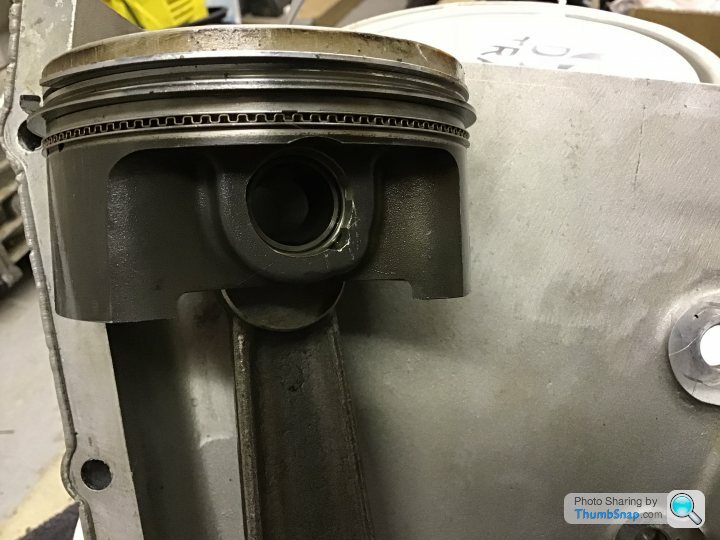
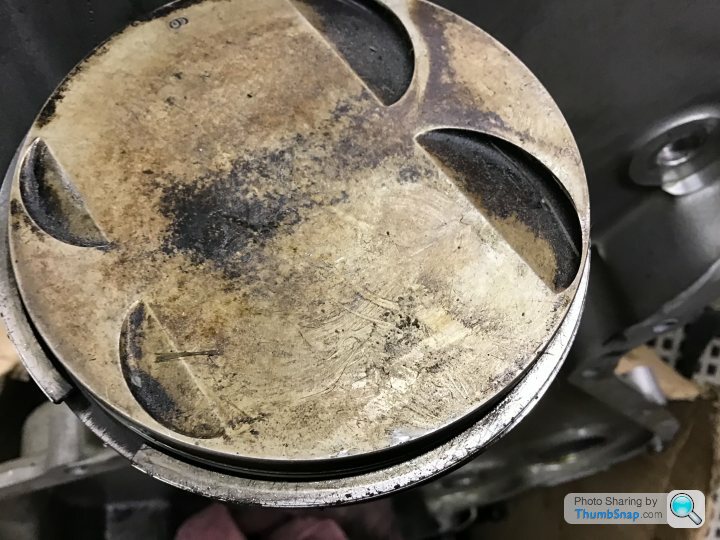
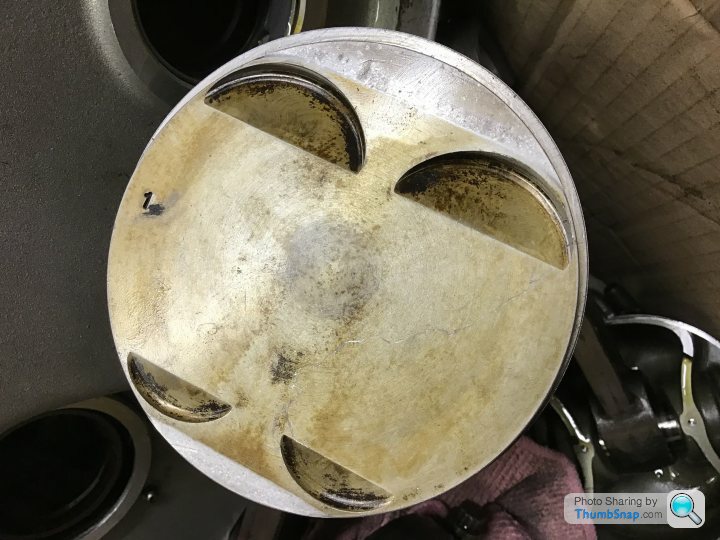
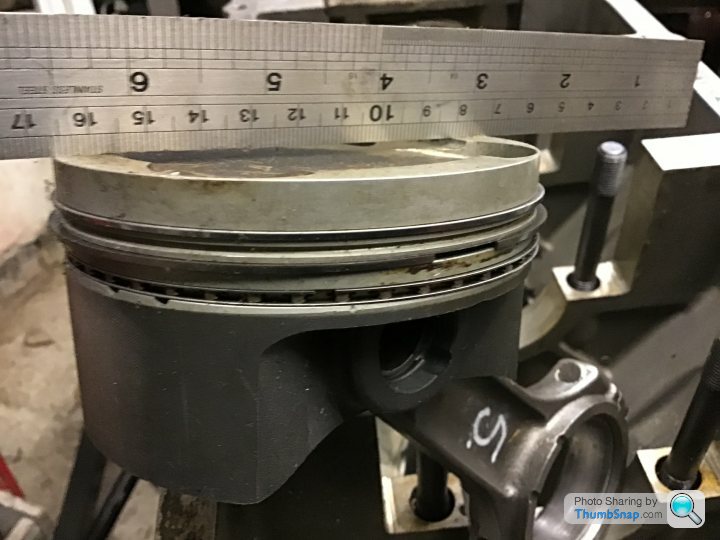
First batch of pics, 3.6 flat top and same with pin high near oil control, same set but what happens when either grinding is offset too much or the rod stretches. A 2mm crown but note the pin is in the lower position, I don’t have a pic of the 2mm crown with the high ring but I have seen one on an S. more pics in next post
J
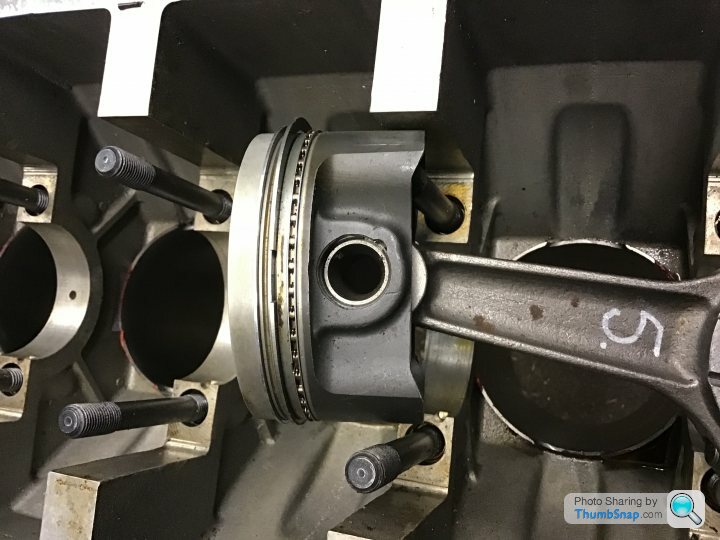
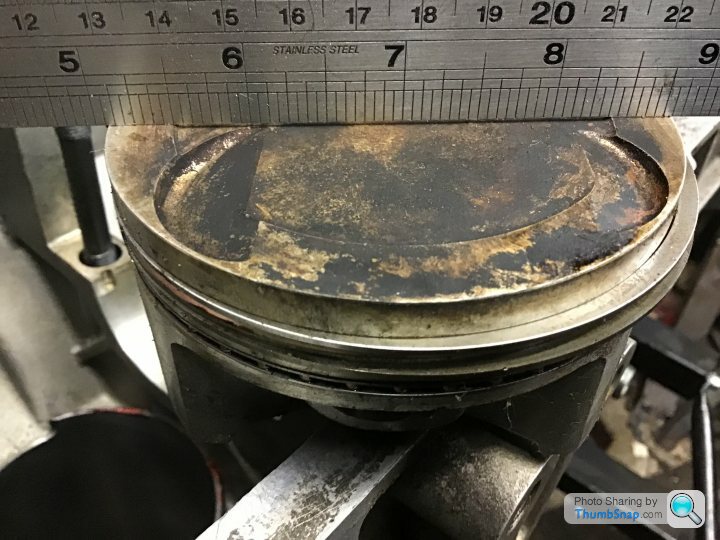
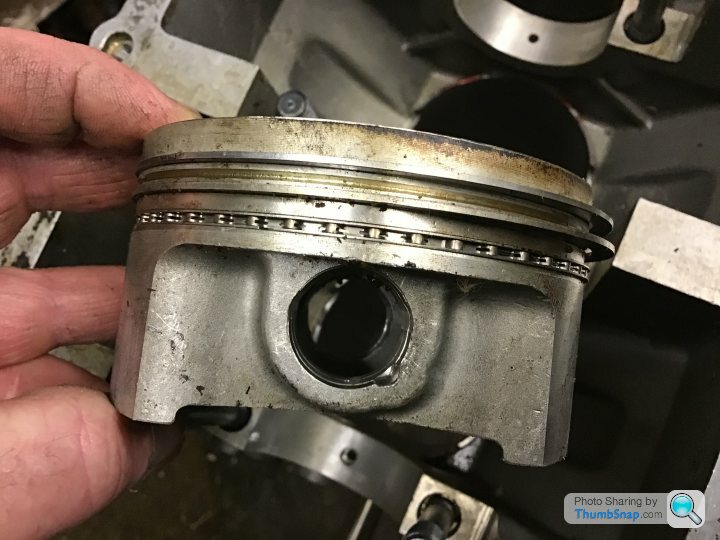
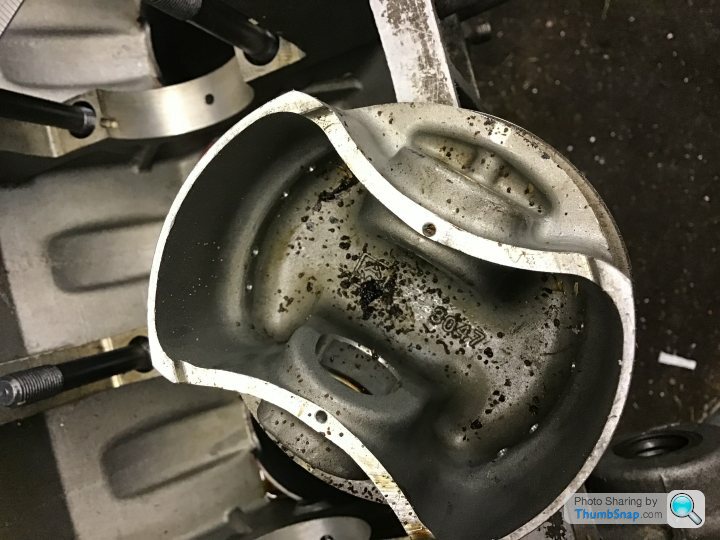
So 2mm crown side view with coated skirt. Easy to read pin position by lack of relief under oil control ring. Last three pics are 1mm crown again with rod in lower position. This was from and early 6, note the skirt has no coating unlike previous set of pics. All gudgen pins are the same size, all pistons are for same bore. I have some pics somewhere of the longer rod/higher pin 2mm crown hobbies but technology and me don’t get on. This took an age to do. Don’t worry too much about pick up, the 911 boys and girls know all about this as they seem to suffer worse than we do.
Hope this answers the question, or maybe confuses more as it’s place your bets as to what is in there when you strip an early one.
J
Hi thanks for taking the time to post this info 
I've seen it written before (in the tvr parts website) that the 3.6 flat piston reduces the compression on a 4 litre, but how can that be if it's not got a bowl in the crown? The lack of bowl should raise compression .. the only way I can see it lowering the compression is if it's got the highest pin position of all the piston versions, or the longest rod, or both, so fitting it in a 4 litre means it doesn't come anywhere near the block deck.
I was hoping to run a flat 3.6 in a 4litre and make a high compression 4 litre. I can see I'm only going to be able to sort it out if I can lay my hands on some 3.6 pistons, various rods etc and physically try some permutations in my block.
Thank you

I've seen it written before (in the tvr parts website) that the 3.6 flat piston reduces the compression on a 4 litre, but how can that be if it's not got a bowl in the crown? The lack of bowl should raise compression .. the only way I can see it lowering the compression is if it's got the highest pin position of all the piston versions, or the longest rod, or both, so fitting it in a 4 litre means it doesn't come anywhere near the block deck.
I was hoping to run a flat 3.6 in a 4litre and make a high compression 4 litre. I can see I'm only going to be able to sort it out if I can lay my hands on some 3.6 pistons, various rods etc and physically try some permutations in my block.
Thank you

Sagi Badger said:
Hi Joolz,
Out of interest what have you revved a 3.6 to and what was it making around 7.5 k? The maths is telling me this is the best capacity match for the intake and exhaust. The cam timing is critical on the sp6 as the snappy profile requires the best use of induction timing vs intake length.
Cheers J
Cliff's race engine always revs to 7800 which is where the limiter is set. I'd like to rev it higher, but in the bottom end it's got 5 conrods of one type, and one of another (can't remember the exact look of them, could be 5 of the supposed good and one bad, or 5 bad lol). It's done hundreds of hours on the dyno too. Never had a failure that was the engine's fault *touch wood* . For reliability it's beaten every other engine it's ever run. Out of interest what have you revved a 3.6 to and what was it making around 7.5 k? The maths is telling me this is the best capacity match for the intake and exhaust. The cam timing is critical on the sp6 as the snappy profile requires the best use of induction timing vs intake length.
Cheers J
Best it made was just over 390hp at 7500rpm. Graph is in the sp6 wiki but the rpm is skewed down the graph slightly as i'd not got the rpm set correctly on the dyno, so torque is slightly exagerrated too (as that's back-calculated from the engine hp and rpm)
Joolz,
The flat top is exactly that, the bowl pistons would better be described as plus crown pistons but the bowl is the same height above the pin as the top of a flat is, for the same pin height of course...kind of makes sense I think.
Thanks for the tech on the 3.6. I think there is potential to get one of these into the 9K area. There simply isn’t enough room for the 4s to breath at this speed but as this was originally designed at 3.5 it seems to make sense although I met a racer who had a 4 that hit 8.4k. I am building a 4.5 at the mo but once I finish that I will mess around on a block with 3.6 crank.
The last 4 I built has flat top pistons and steel rods, it decked out plus 10 thou from memory, there is enough top land that I wasn’t so worried about the top ring having a rough time. I try to get 35 thou between head and crown at TD, could try less, hey ho got a couple of spares. If you are push CR up check the cc on 1 and 6, the heads cool asymmetrically post cast and once skimmed 1 and 6 can be smaller than the rest, it sometimes shows on the valve seats, worth checking clearance either end.
It is too late to go and measure pistons but I think the increments are 100 thou same as the rod steps, guessing here and I am getting grief for not doing Christmas type things.
Enjoy the turkey and stuffing etc.
Cheers j
The flat top is exactly that, the bowl pistons would better be described as plus crown pistons but the bowl is the same height above the pin as the top of a flat is, for the same pin height of course...kind of makes sense I think.
Thanks for the tech on the 3.6. I think there is potential to get one of these into the 9K area. There simply isn’t enough room for the 4s to breath at this speed but as this was originally designed at 3.5 it seems to make sense although I met a racer who had a 4 that hit 8.4k. I am building a 4.5 at the mo but once I finish that I will mess around on a block with 3.6 crank.
The last 4 I built has flat top pistons and steel rods, it decked out plus 10 thou from memory, there is enough top land that I wasn’t so worried about the top ring having a rough time. I try to get 35 thou between head and crown at TD, could try less, hey ho got a couple of spares. If you are push CR up check the cc on 1 and 6, the heads cool asymmetrically post cast and once skimmed 1 and 6 can be smaller than the rest, it sometimes shows on the valve seats, worth checking clearance either end.
It is too late to go and measure pistons but I think the increments are 100 thou same as the rod steps, guessing here and I am getting grief for not doing Christmas type things.
Enjoy the turkey and stuffing etc.
Cheers j
I've had chance to pull the pistons from my poorly 4 litre engine out of the tuscan.
I've also got a set of Sagaris pistons and rods kindly given to me by a customer.
The Sag piston has a small bowl, higher gudgeon pin and longer rods than my std 4 litre tuscan items so ..
at the moment I could potentially use my longer sagaris rods with the low gudgeon pin std 4 litre pistons machined flat top .. I have two different 3.6 pistons and rods coming from another customer so I can have a look at those too and see what might work best.
Both the sag and my std 4 litre pistons are 3047 and conrods are 1546. No idea at the moment if this is good or bad, but on the basis that the sag was a late tvr model, and my 4 litre engine was a powers rebuild, I'm hoping they're better quality items.
When I've got the 3.6 items here I will re-visit it all and try and work out the combination I'm going to use, but at the moment the sag rods and my std pistons machined would get me what i want.
I've also got a set of Sagaris pistons and rods kindly given to me by a customer.
The Sag piston has a small bowl, higher gudgeon pin and longer rods than my std 4 litre tuscan items so ..
at the moment I could potentially use my longer sagaris rods with the low gudgeon pin std 4 litre pistons machined flat top .. I have two different 3.6 pistons and rods coming from another customer so I can have a look at those too and see what might work best.
Both the sag and my std 4 litre pistons are 3047 and conrods are 1546. No idea at the moment if this is good or bad, but on the basis that the sag was a late tvr model, and my 4 litre engine was a powers rebuild, I'm hoping they're better quality items.
When I've got the 3.6 items here I will re-visit it all and try and work out the combination I'm going to use, but at the moment the sag rods and my std pistons machined would get me what i want.
Joolz,
HNY.
What you will need to watch is the valve pocket depth. The rods step in 100 thou and the pin heights do the same. I think if there is enough block height you may get the crown machined down enough but the valves may not clear. The piston castings are all numbered the same, as are the rods. The “better” spec rods look nicer than the not so good ones but I don’t trust either. The heavy weight on the little end scares me enough without the unknown metalogially of the thing.
The shorter rod on the early 4s I think originates from an attempt to improve the breathing by altering rod ratio, it moves the piston quicker, ever so slightly, from TDC and initiates the suck a fraction earlier. The maths on these makes the intakes undersized for the 4 litre at the kind of speed I would like to spin one at although for road use they are fine but I suspect someone in TVR was chasing numbers at some time and tried to nick a bit more. For durability and common sense I would use a long rod. Something else to watch is the first and last pot, the head casting crowns slightly during cooling after casting and when machined flat 1 and 6 are most likely to be under capacity so cc the head, especially if you are pushing up the CR. The core plug at the back is ripe for a water take off and will help to cool the head more evenly.
One more thing to consider is off set grinding a crank. I have a billet 4 litre crank that is the victim of a shoddy grind, 2 journals... yep 1 and 6, have 20 thou more stroke. Genius. It ran OK as well. This will take another grind and I will get this off set on all the journals, hopefully.
Keep me posted, pls.
Cheers J
HNY.
What you will need to watch is the valve pocket depth. The rods step in 100 thou and the pin heights do the same. I think if there is enough block height you may get the crown machined down enough but the valves may not clear. The piston castings are all numbered the same, as are the rods. The “better” spec rods look nicer than the not so good ones but I don’t trust either. The heavy weight on the little end scares me enough without the unknown metalogially of the thing.
The shorter rod on the early 4s I think originates from an attempt to improve the breathing by altering rod ratio, it moves the piston quicker, ever so slightly, from TDC and initiates the suck a fraction earlier. The maths on these makes the intakes undersized for the 4 litre at the kind of speed I would like to spin one at although for road use they are fine but I suspect someone in TVR was chasing numbers at some time and tried to nick a bit more. For durability and common sense I would use a long rod. Something else to watch is the first and last pot, the head casting crowns slightly during cooling after casting and when machined flat 1 and 6 are most likely to be under capacity so cc the head, especially if you are pushing up the CR. The core plug at the back is ripe for a water take off and will help to cool the head more evenly.
One more thing to consider is off set grinding a crank. I have a billet 4 litre crank that is the victim of a shoddy grind, 2 journals... yep 1 and 6, have 20 thou more stroke. Genius. It ran OK as well. This will take another grind and I will get this off set on all the journals, hopefully.
Keep me posted, pls.
Cheers J
Hi!
If I was a bit wealthier than I am I would be buying the racing green / tvr parts rods which at 600/set seem good value, and getting dave at performance unlimited to source me some pistons (he has experience with tvr ajp8 and sp6 engines already) but this will have to be a budget built I'm afraid so I will be using secondhand components and as much work done by me as possible.
A re-lined block with large bore and offset ground crank would be great but it will have to stay a 4 litre, and I quite like the idea of pushing the std capacity as far as I can power wise on a tiny budget. Everything on the 3.6 in the T350R is done by me with the exception of the merge collector manifolds left over from a previous ill fated 3rd party engine build but I don't think they're contributing anything anyway.
I'd thought about the valve pockets and I will have to swing the cams to make sure I've got more than enough clearance obviously, but that's the fun bits anyway as it's time rather than expense to check these things. As I say I won't know what combination of std components to use until I've investigated it all .. you're way ahead of me on all this though so I value your info, many thanks.
I have several sets of cams here so if I don't have any clearance issues I might get a pair reground.
One thing I am conscious of is that there have been attempts to build high hp engines which have fallen waaay short of the mark, less than std power in some cases for teens of thousands of pounds. By contrast, careful fettling of a basically std engine can give good rewards .. I'm very keen on the gradual fettling of the std parts to give power rather than spending vast sums on components which potentially may not work well together. I've seen a few of those not-very-good engines on the dyno and I need to spend any money wisely.
If we work on the basis that a good tuscan S on my dyno makes around 370-375bhp then a short inlet airbox, tapered intakes/thinned spindles, remap, higher compression and some basic head porting must surely be worth the 30hp to push me over the 400hp mark .. that work on the 3.6 made me 40hp extra with a better exhaust system arrangement so it's looking good on paper .. the 417hp of clive ford's original sagaris engine is the number to beat .. I believe that's still the best *basically standard* engine that's been tested?
If I was a bit wealthier than I am I would be buying the racing green / tvr parts rods which at 600/set seem good value, and getting dave at performance unlimited to source me some pistons (he has experience with tvr ajp8 and sp6 engines already) but this will have to be a budget built I'm afraid so I will be using secondhand components and as much work done by me as possible.
A re-lined block with large bore and offset ground crank would be great but it will have to stay a 4 litre, and I quite like the idea of pushing the std capacity as far as I can power wise on a tiny budget. Everything on the 3.6 in the T350R is done by me with the exception of the merge collector manifolds left over from a previous ill fated 3rd party engine build but I don't think they're contributing anything anyway.
I'd thought about the valve pockets and I will have to swing the cams to make sure I've got more than enough clearance obviously, but that's the fun bits anyway as it's time rather than expense to check these things. As I say I won't know what combination of std components to use until I've investigated it all .. you're way ahead of me on all this though so I value your info, many thanks.
I have several sets of cams here so if I don't have any clearance issues I might get a pair reground.
One thing I am conscious of is that there have been attempts to build high hp engines which have fallen waaay short of the mark, less than std power in some cases for teens of thousands of pounds. By contrast, careful fettling of a basically std engine can give good rewards .. I'm very keen on the gradual fettling of the std parts to give power rather than spending vast sums on components which potentially may not work well together. I've seen a few of those not-very-good engines on the dyno and I need to spend any money wisely.
If we work on the basis that a good tuscan S on my dyno makes around 370-375bhp then a short inlet airbox, tapered intakes/thinned spindles, remap, higher compression and some basic head porting must surely be worth the 30hp to push me over the 400hp mark .. that work on the 3.6 made me 40hp extra with a better exhaust system arrangement so it's looking good on paper .. the 417hp of clive ford's original sagaris engine is the number to beat .. I believe that's still the best *basically standard* engine that's been tested?
Joolz,
Agree with all of this. I had a near zero budget before I met the wife and I have a minus budget now... but... I managed to find a sweet spot in my teens on the A series 1300 before I read the Vizard book later and understood what I had done. My mates were finding other sweet spots so didn’t care much about what I said about engines. My theory of how my improvements had worked at the time was correct, more by luck I think as I didn’t spend long thinking about it but it taught me a lot. I read a few years later something by Dave Baker, written in about 88 I think, about the CVH and how the most value and best gains he found were on the inlet and other mods gave little benefit, especially per pound spent.
The red tops make serious numbers and these are all intake tackle when you look at them, they taper as well. YBs that are converted to NA don’t do bad either and the mods follow a similar pattern. I could list more but I think we are on the same page and have similar aims. When I first looked at the SP6 I thought there is more to come out of this, but this is at the expense of driveability as the two previous examples do the biz when you “cam” them up.
What I do know is there is little to gain by lifting the valves any higher and I have been told by someone who spent a lot of time on this on a rolling road that there is more on offer by retarding the cams but idle and low end power does suffer. The maths tells me increase duration and overlap. I want to spin one fast, and I know I need to spend money to do this and not collect shrapnel in the process. Someone else in the SP6 circus with a rolling road said to me, when questioned, that there is little gain in swapping the exhaust manifolds although I do think a change in length and up an 1/8 on the bigger capacity motors makes sense, more on this another day. The cat flange makes a good sonic barrier for all those reversal waves we are supposed to be tuning around, well that’s as far as my tech goes on that so a merge collector is much the same to the gases that hammer past it so I would agree little point unless the length is altered to a new target. What I think does limit is the head area per cc per pot. The other engines I note are around 500 to 550 per pot but we have 660 and more but valves that are only around 10% bigger.
Feel free to pm me and I will share what I know and what I have been told and consider valid, I have met someone who claimed a lot but frankly.... no it didn’t ring true although one bit made sense.
J
Agree with all of this. I had a near zero budget before I met the wife and I have a minus budget now... but... I managed to find a sweet spot in my teens on the A series 1300 before I read the Vizard book later and understood what I had done. My mates were finding other sweet spots so didn’t care much about what I said about engines. My theory of how my improvements had worked at the time was correct, more by luck I think as I didn’t spend long thinking about it but it taught me a lot. I read a few years later something by Dave Baker, written in about 88 I think, about the CVH and how the most value and best gains he found were on the inlet and other mods gave little benefit, especially per pound spent.
The red tops make serious numbers and these are all intake tackle when you look at them, they taper as well. YBs that are converted to NA don’t do bad either and the mods follow a similar pattern. I could list more but I think we are on the same page and have similar aims. When I first looked at the SP6 I thought there is more to come out of this, but this is at the expense of driveability as the two previous examples do the biz when you “cam” them up.
What I do know is there is little to gain by lifting the valves any higher and I have been told by someone who spent a lot of time on this on a rolling road that there is more on offer by retarding the cams but idle and low end power does suffer. The maths tells me increase duration and overlap. I want to spin one fast, and I know I need to spend money to do this and not collect shrapnel in the process. Someone else in the SP6 circus with a rolling road said to me, when questioned, that there is little gain in swapping the exhaust manifolds although I do think a change in length and up an 1/8 on the bigger capacity motors makes sense, more on this another day. The cat flange makes a good sonic barrier for all those reversal waves we are supposed to be tuning around, well that’s as far as my tech goes on that so a merge collector is much the same to the gases that hammer past it so I would agree little point unless the length is altered to a new target. What I think does limit is the head area per cc per pot. The other engines I note are around 500 to 550 per pot but we have 660 and more but valves that are only around 10% bigger.
Feel free to pm me and I will share what I know and what I have been told and consider valid, I have met someone who claimed a lot but frankly.... no it didn’t ring true although one bit made sense.
J
Gassing Station | Speed Six Engine | Top of Page | What's New | My Stuff



